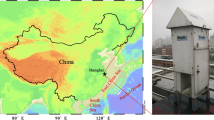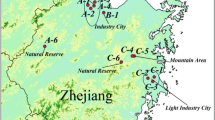Abstract
Protecting the population from aerosol pollution relies on forecasts using models with aerosol composition, yet the respective contributions of aerosol components are poorly known. In particular, the contribution of inorganic condensable particulate matter (PM) to aerosols is likely to be underestimated in most models because condensable particulate matter exceeds the amount of filterable particulate matter in emissions from stationary combustion sources. Moreover, condensable particulate matter is rarely included in current emission inventories. Here, we estimated the emissions of inorganic condensable particulate matter from stationary combustion sources based on monitoring information in China. Then we modeled the contributions of condensable particulate matter to simulated inorganic aerosols, e.g., sulfate, ammonium, and nitrate by designing a series of sensitivity simulation scenarios. The results show that the estimated emissions of inorganic components over mainland China are increased about five times after including inorganic condensable particulate matter, for both 2014 and 2017. Specifically, taking into account the inorganic condensable particulate matter, increased the average concentrations of sulfate by 104%, ammonium by 10%, nitrate by 11%, and PM2.5 by 21% for the Hangzhou site in December 2017. Similarly, the simulated average daily concentrations of sulfate from December 3 to 31, 2017, more than doubled, increasing from 3.17 to 8.41 μg m−3 for Gucheng, 7.70 to 16.75 μg m−3 for Chengdu, 4.08 to 9.43 μg m−3 for Lin’an, and 3.19 to 7.22 μg m−3 for Dalian.



Similar content being viewed by others
Data availability
The emission data and model results are available upon request.
References
Cano M, Vega F, Navarrete B, Plumed A, Camino JA (2017) Characterization of emissions of condensable particulate matter in clinker kilns using a dilution sampling system. Energy Fuels 31:7831–7838
Chen D, Liu Z, Fast J, Ban J (2016) Simulations of sulfate-nitrate-ammonium (SNA) aerosols during the extreme haze events over northern China in October 2014. Atmos Chem Phys 16:10707–10724. https://doi.org/10.5194/acp-16-10707-2016
Cheng Y, Zheng G, Wei C, Mu Q, Zheng B, Wang Z, Gao M, Zhang Q, He K, Carmichael G, Pöschl U, Su H (2016) Reactive nitrogen chemistry in aerosol water as a source of sulfate during haze events in China. Sci Adv 2:e1601530–e1601530. https://doi.org/10.1126/sciadv.1601530
Feng Y, Li Y, Cui L (2018) Critical review of condensable particulate matter. Fuel 224:801–813. https://doi.org/10.1016/j.fuel.2018.03.118
Gao J, Li Y, Li J, Shi G, Liu Z, Han B, Tian X, Wang Y, Feng Y, Russell AG (2021) Impact of formation pathways on secondary inorganic aerosol during haze pollution in Beijing: quantitative evidence from high-resolution observation and modeling. Geophys Res Lett 48:1–11. https://doi.org/10.1029/2021GL095623
Li J, Qi Z, Li M, Wu D, Zhou C, Lu S, Yan J, Li X (2017) Physical and chemical characteristics of condensable particulate matter from an ultralow-emission coal-fired power plant. Energy Fuels 31:1778–1785. https://doi.org/10.1021/acs.energyfuels.6b02919
Li M, Yu S, Chen X et al (2022) Impacts of condensable particulate matter on atmospheric organic aerosols and fine particulate matter (PM2.5) in China. Atmos Chem Phys 22:11845–11866. https://doi.org/10.5194/acp-22-11845-2022
Liu M, Huang X, Song Y et al (2019) Ammonia emission control in China would mitigate haze pollution and nitrogen deposition, but worsen acid rain. Proc Natl Acad Sci 116:7760–7765. https://doi.org/10.1073/pnas.1814880116
Reff A, Bhave PV, Simon H, Pace TG, Pouliot GA, Mobley JD, Houyoux M (2009) Emissions inventory of PM2.5 trace elements across the United States. Environ Sci Technol 43:5790–5796. https://doi.org/10.1021/es802930x
Shao J, Chen Q, Wang Y, Lu X, He P, Sun Y, Shah V, Martin RV, Philip S, Song S, Zhao Y, Xie Z, Zhang L, Alexander B (2019) Heterogeneous sulfate aerosol formation mechanisms during wintertime Chinese haze events: air quality model assessment using observations of sulfate oxygen isotopes in Beijing. Atmos Chem Phys 19:6107–6123. https://doi.org/10.5194/acp-19-6107-2019
Tao J, Zhang L, Cao J, Zhang R (2017) A review of current knowledge concerning PM2.5 chemical composition, aerosol optical properties and their relationships across China. Atmos Chem Phys 17:9485–9518
Wang Y, Wang Y, Wang L, Petaja T, Zha Q, Gong C, Li S, Pan Y, Hu B, Xin J, Kulmala M (2019) Increased inorganic aerosol fraction contributes to air pollution and haze in China. Atmos Chem Phys 19:5881–5888. https://doi.org/10.5194/acp-19-5881-2019
Wang G, Deng J, Zhang Y, Li Y, Ma Z, Hao J, Jiang J (2020) Evaluating airborne condensable particulate matter measurement methods in typical stationary sources in China. Environ Sci Technol 54:1363–1371. https://doi.org/10.1021/acs.est.9b05282
Wang K, Gao J, Liu K, Tong Y, Dan M, Zhang X, Liu C (2022) Unit-based emissions and environmental impacts of industrial condensable particulate matter in China in 2020. Chemosphere 303:134759. https://doi.org/10.1016/j.chemosphere.2022.134759
Wu B, Bai X, Liu W, Lin S, Liu S, Luo L, Guo Z, Zhao S, Lv Y, Zhu C, HaoY LY, Hao J, Duan L, Tian H (2020) Non-negligible stack emissions of noncriteria air pollutants from coal-fired power plants in china: condensable particulate matter and sulfur trioxide. Environ Sci Technol 54:6540–6550. https://doi.org/10.1021/acs.est.0c00297
Wyat Appel K, Bash JO, Fahey KM et al (2021) The community multiscale air quality (CMAQ) model versions 5.3 and 5.3.1: system updates and evaluation. Geosci Model Dev 14:2867–2897. https://doi.org/10.5194/gmd-14-2867-2021
Xie X, Hu J, Qin M et al (2022) Modeling particulate nitrate in China: current findings and future directions. Environ Int 166:107369. https://doi.org/10.1016/j.envint.2022.107369
Yu S, Mathur R, Pleim J et al (2014) Aerosol indirect effect on the grid-scale clouds in the two-way coupled WRF-CMAQ: Model description, development, evaluation and regional analysis. Atmos Chem Phys 14:11247–11285. https://doi.org/10.5194/acp-14-11247-2014
Zhai S, Jacob DJ, Wang X et al (2021) Control of particulate nitrate air pollution in China. Nat Geosci 14:389–395. https://doi.org/10.1038/s41561-021-00726-z
Zheng H, Cai S, Wang S, Zhao B, Chang X, Hao J (2019) Development of a unit-based industrial emission inventory in the Beijing-Tianjin-Hebei region and resulting improvement in air quality modeling. Atmos Chem Phys 19:3447–3462. https://doi.org/10.5194/acp-19-3447-2019
Acknowledgements
The authors would like to thank the comprehensive data collection and sharing platform for atmospheric environmental science as well as the CERN Atmospheric Science Branch of the Institute of Atmospheric Physics, Chinese Academy of Sciences, for providing measurement data of inorganic ions.
Funding
This research was supported by the National Natural Science Foundation of China (grant nos. 42175084, 21577126, and 41561144004), the Department of Science and Technology of China (grant nos. 2018YFC0213506 and 2018YFC0213503), and the National Research Program for Key Issues in Air Pollution Control in China (grant no. DQGG0107). Pengfei Li was supported by the National Natural Science Foundation of China (grant no. 22006030), the Science and Technology Program of Hebei Province (grant no. 22343702D), the Research Foundation of Education Bureau of Hebei (grant no. BJ2020032), and the Initiation Fund of Hebei Agricultural University (grant no. 412201904).
Author information
Authors and Affiliations
Contributions
SY and PL conceived and designed the research. ML performed the model simulations. ML conducted data analysis. XC, ZS, WL, XZ, EL, DR, and JHS contributed to the scientific discussions. MZ, YS, ZL, and JJ provided observational data. SY, ML, PL, and JHS wrote and revised the manuscript.
Corresponding authors
Ethics declarations
Conflict of interest
The authors declare that they have no conflict of interest.
Additional information
Publisher's Note
Springer Nature remains neutral with regard to jurisdictional claims in published maps and institutional affiliations.
Supplementary Information
Below is the link to the electronic supplementary material.
Rights and permissions
Springer Nature or its licensor (e.g. a society or other partner) holds exclusive rights to this article under a publishing agreement with the author(s) or other rightsholder(s); author self-archiving of the accepted manuscript version of this article is solely governed by the terms of such publishing agreement and applicable law.
About this article
Cite this article
Li, M., Yu, S., Li, P. et al. Unrecognized pollution by inorganic condensable particulate matter in the atmosphere. Environ Chem Lett 22, 49–56 (2024). https://doi.org/10.1007/s10311-023-01644-9
Received:
Accepted:
Published:
Issue Date:
DOI: https://doi.org/10.1007/s10311-023-01644-9




